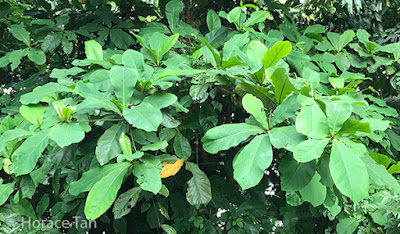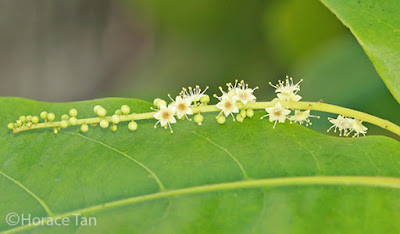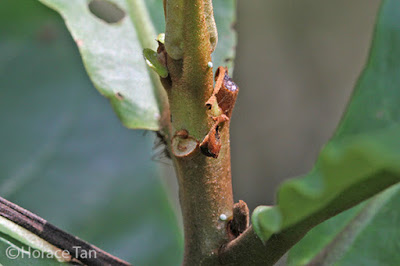The Sea Almond (Terminalia catappa)
This 13th instalment of our Butterflies' Larval Host Plants series features Terminalia catappa
(Sea Almond), a member of Combretaceae which is a family of flowering plants comprising about 530 species of trees, shrubs and lianas. Sea Almond is a perennial and deciduous member which assumes the tree form.
The genus name "Terminalia" refers to the plants’ leaves being clustered at the end of branches.
The genus name "Terminalia" refers to the plants’ leaves being clustered at the end of branches.
A wild Sea Almond tree at the water edge of Jurong Lake.
Sea Almond is native to tropical Asia, North Australia and Polynesia. It has been introduced to and cultivated in many other tropical and sub-tropical regions. In Singapore, it can be found growing wild along the coast, on rocky and sandy beaches. It is also commonly planted in parks/gardens and along roadsides as ``shade'' trees.
A young Sea Almond plant next to a park connector.
Plant Biodata :
Family: Combretaceae
Genus: Terminalia
Species: catappa
Synonyms: T. procera, T. latifolia, T. moluccana.
Country/Region of Origin: Tropical Asia, North Australia and Polynesia.
English Common Name: Sea Almond
Other Common Names: Pacific Almond, Ketapang, Indian Almond, Tropical Almond Tree, 榄仁树.
Larval Host for Butterfly Species: Arhopala centaurus nakula (Centaur Oakblue), Flos apidanus saturatus (Plain Plushblue), Spindasis lohita senama (Long Banded Silverline).
Rows of cultivated Sea Almond trees on both sides of the road in the Jurong district.
Young shoots growing from the trunk of a mature Sea Almond tree.
Buttress roots of a Sea Almond tree.
Sea Almond is a fast growing tree with spreading canopy and a tiered growth form. It can grow to a height of 20-35m, and often has buttress roots. Its thin leathery leaves are large (8–38 cm long, 5–19 cm wide), spatula-shaped and spirally arranged at the end of the twigs. The leaves are shed up to twice a year with the colour turning yellow and read before dropping off.
Spirally arranged leaves of the Sea Almond.
Spirally arranged leaves of the Sea Almond seen against the sky.
A leaf of the Sea Almond, notes its spatulate leaf shape.
Young developing leaves are yellowish brown to reddish, turning yellowish green to dark green when they mature. Leaves of Sea Almond contains tannins, and are used in tanning and dyeing. Other uses include treatment of headache and colic (using juice of young leaves), and topical treatment for rheumatic joints (in Indonesia and India).
Young leaves of the Sea Almond.
Developing leaves of the Sea Almond.
A twig bearing young, developing leaves of the Sea Almond.
Sea Almond is monoecious. Many tiny, white, petal-less flowers occur on long spikes emanating from leaf axils. Male flowers occur at the tip of the spike while the female flowers are at the bottom end.
A spike bearing flower buds of the Sea Almond.
A spike with flower buds at the tip and flowers at the bottom end.
A spike bearing numerous flower buds of the Sea Almond.
Close-up view of flowers of the Sea Almond.
Fruits are almond-shaped (3.5-7cm long), occurring in small clusters. Each fruit has a leathery, corky outer layer and a thick stony core containing the seed. It is initially green, turning yellow or red when ripened. The fruit is buoyant and can still viable after days in water.
A branch of the Sea Almond bearing developing fruits.
Fallen fruits of the Sea Almond.
The seed germinates with two near kidney-shaped cotyledons. Other young leaves follow thereafter.
A newly germinated Sea Almond plant. Note the seed (arrowed) and the two cotyledons.
Close-up view of the two cotyledons.
In Singapore, the Sea Almond serves as the larval host plant for three butterfly species in the Lycaenidae family:
Centaur Oakblue,
Plain Plushblue ,
Long Banded Silverline.
A Centaur Oakblue.
A Plain Plushblue.
A Long Banded Silverline.
Eggs of the three lycaenid species are laid singly or in small groups on young shoots, petioles or young leaves of the Sea Almond. Those of the Long Banded Silverline can also be found in crevices or cracks on the trunk.
Eggs of the Centaur Oakblue laid on twigs of Sea Almond.
Two close-up views of an egg of the Centaur Oakblue.
Eggs of the Plain Plushblue Oakblue laid on young shoots of Sea Almond.
A group of eggs of the Plain Plushblue.
Close-up views of two eggs of the Long Banded Silverline.
Caterpillars of all three lycaenid species feed on young leaves of the Sea Almond. They live in close association with ants, and are typically sighted with a few ants in attendance. Caterpillars of the Long Banded Silverline even share residence with ants in latter's pavilion on the leaf underside. Caterpillars of the Centaur Oakblue and the Plain Plushblue typically build their own shelters on the leaf for rest and concealment. It is not unusual to find a fair number of ants in such leaf shelters.
A group of weaver's ants attending to a caterpillar of the Centaur Oakblue.
Two views of a caterpillar of the Centaur Oakblue.
Two young caterpillars of the Plain Plushblue being attended by two ants.
Two views of a caterpillar of the Plain Plusblue
A caterpillar of the Long Banded Silverline hiding in an ant pavilion.
Two views of a 5th instar caterpillar of the Long Banded Silverline.
References:
- The Concise Flora of Singapore : Hsuan Keng Singapore University Press, 1990.
- WildSingapore - Sea Almond.
- LKCNHM, The DNA of Singapore - Terminalia catappa.
- NPark's Flora Fauna Web - Terminalia catappa.
- The Plant Observatory - Terminalia catappa.
Text and Photos by Horace Tan.


































No comments:
Post a Comment